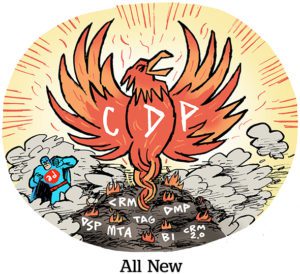“Data-Driven Thinking” is written by members of the media community and contains fresh ideas on the digital revolution in media.
With the forthcoming “cookie-pocalypse” threatening to reign havoc across the advertising industry, the time has come for a major shift in mindset on audience targeting.
Ad tech must quit its addiction to user IDs and instead start focusing on how we can innovate in other areas: audience targeting, managing frequency and improving measurement (especially conversion attribution).
Meanwhile, as we wait to see which (if any) universal ID methods come along to replace third-party cookies, contextual and geo-based targeting are a great way to reach an audience and get better than expected ROI on campaigns.
Contextual and geo-based targeting are viable options
These tactics have been around in some form for a while now, and for good reason: they work. After all, contextual audience targeting is a solution that helps advertisers reach key, segmented demographics, is privacy-friendly and scalable, and is remarkably budget-friendly.
If the idea of audience targeting in a campaign is to have better results than just throwing an ad out into the world and hoping for the best, then contextual targeting delivers by definition. “Contextual” also means a lot more than some people think it does. There’s contextual in a technical sense, in which you attach a classification to a page URL or an app based on their contents, but it can actually do a lot more.
Two great examples: Comscore offers demographic targeting, and Peer39 offers a variety of psychographic audiences, both fueled by panel data that identifies URLs those target audiences are most likely to visit.
As for geo-derived data, there’s often significant geographic clustering based on household income, ethnicity, and psychographics. A variety of companies have been using this type of data to power their targeting efforts for years, but digital advertisers have not embraced them because they don’t involve user IDs. It’s time for that to change.
To top it all off, contextual and geo-based targeting are often dramatically more cost-effective than user ID-based targeting – like, 10x more. The CPM for user ID-based ads can run about $1-$2, while the CPM for a contextual placement may be closer to 10-15 cents.
If you’re approaching campaigns from a cost per acquisition perspective, you only need your contextual ads to be 10% as effective to see the same results. At that point, who cares if you waste a few impressions in the process, as long as you’re still reaching your target demo and hitting your overall campaign goals? Besides, you might even inadvertently pick up a few new customers along the way.
Additionally, contextual targeting neatly sidesteps the privacy landmines surrounding ID-based targeting because it doesn’t use personal data. That makes it a more robust and compatible solution for a future where both legislators and browser makers are looking to give users more privacy.
And besides, the very idea of contextual or location-based advertising is often more appealing to people outside the ad industry, who can easily comprehend and accept the idea of seeing ads that target a situation rather than a person.
Stepping back to leap forward
Though it may feel like it, these methods aren’t a step back. These are data-driven ways of targeting your audiences that everyone outside of online advertisers is successfully using right now. So I say: Why not embrace it?
Instead of dismissing it out of habit, let’s celebrate their benefits and work to optimize our contextual and geo-targeted campaigns for maximum ROI. We can successfully measure their input with cost effectiveness and with frequency management. Because, if a targeting tactic is cost effective and helps you reach your audiences, what does it matter if it’s classification of ZIP codes or classifications of user IDs?
Follow Basis (@basisglobaltech) and AdExchanger (@adexchanger) on Twitter.
For more articles featuring Ian Trider, click here.














